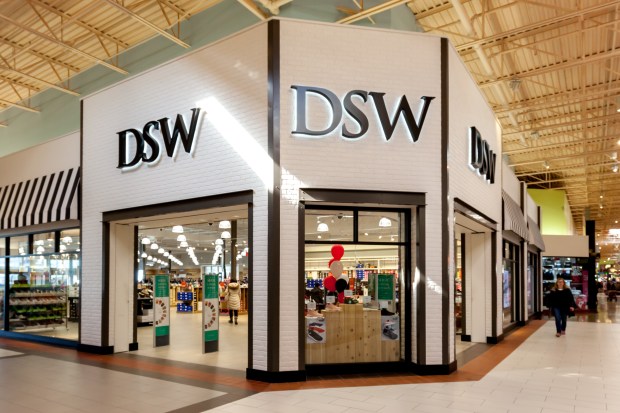DSW’s Amazon-Proof Makeover Move

In an era that has seen physical retail locations — particularly large box stores — suffer from consumers becoming increasingly enamored with the online experience, it was still a bit of a surprise to see shoe retailer DSW log something of a bumpy 2017. Sales were on the rise for three consecutive quarters, but fall saw those figures taking a surprise tumble and raising concerns among investors who worried that perhaps the brand had lost a step.
For its part, DSW wrote the slip off to the back-to-back-to-back hurricanes that hit hard during the early fall, but a brand’s challenges so simply cannot be blamed on the rain, so to speak. In the background is Amazon and its subsidiary Zappos, both of which offer convenience and the privacy to try on shoes (and properly sashay in them without concerns about judgy prying eyes).
DSW has taken some time to decide how it can best leverage that competitive advantage in a changing retail marketplace. The retailer acquired retail sites ShoeMetro and ApparelSave in 2016 as part of a push to grow its Ebuys platform’s sales. But going into eCommerce isn’t flip-a-switch easy, and though the firm tried to make the business work with new management in 2017, it was writing down the value of eBuys on its balance sheet to the tune of $52.7 million by November — after taking a loss because of huge markdowns to clear inventory.
The shoe retailer even tried to sell eBuys, but there were no takers. That left DSW with only shuttering and liquidation as options.
“The challenge of sourcing the right merchandising in a sustainable way, and the requirements to scale the business, entails unacceptable economics in the near term,” chief financial officer Jared Poff told analysts when the firm announced its decision to close Ebuys in March. It was not a choice that left many too broken-hearted, though, given the expansion’s non-contribution to DSW’s future fortunes.
“The business model for this just wasn’t their core competency, and they had bigger fish to fry,” said Sam Poser, an analyst at Susquehanna Financial Group, which helps facilitate DSW stock trades.
What, exactly, were those bigger fish? The shoe retailer has offered its answer this week, hitting the reset button on loyalty and redesigning the shoe shopping experience in its physical locations. It had officially kicked off its grand repositioning as of September 2017, focusing on creating an “emotional connection” beyond merely trying on new shoes after making a trip to the shoe store. Instead, DSW wants to create a fully inviting and interactive experience.
Pedicures, interestingly enough, are key to this plan.
“Given DSW’s mission of inspiring self-expression, manicures and pedicures make so much sense,” DSW’s chief commercial officer, Simon Nankervis, told Bustle in an email. “Dedicated nail customers also come back to the store every few weeks, making it an ideal traffic-driver for our business.”
One cannot currently stroll into any DSW and get a polish repair, though, as the experience is one of many to be found in DSW’s concept store in Columbus, Ohio. The mani/pedis are found alongside a shoe concierge and a much, much larger assortment of 70,000 shoes — the average DSW store boasts just 20,000 or so.
“We are a firm believer that if you are a brand of brands, and not finding a way to differentiate your model, you will go away,” DSW CEO Roger Rawlins noted in an interview with Forbes.
The remodel is undeniably paying dividends. A year in, the Polaris store pulls in sales that are 10 percent higher on average than its more standard counterparts. While it is a one-location sensation today, the goal, according to Rawlins, is to expand the offerings throughout the 517 stores that make up the chain.
“We want to make something that can be replicated across the organization,” Rawlins said. “The whole idea… is to evolve our customer experience.”
To support those experiences, DSW has also rethought the experience of walking through the store itself. It sought to redesign its brick-and-mortar layouts to better reflect the image of how its customers shop online. The new store design makes it easy for consumers to filter to selections of shoes that fit their specific needs and wants, and DSW added children’s shoes to its lineup — so, of course, there is a children’s section. There are also sections for options that are a bit more specialized, like the so-called Nike niche.
In addition, DSW’s new design features shelving on wheels, meaning a store can full tilt restructure its layout overnight. That new shelving makes it possible for employees to stack shoe inventory higher than before, which, in turn, frees up more floor space for things like nail parlors and other experience-building add-ons.
“The vertical space lets us use only 40 percent of the store footprint,” Rawlins told the Columbus Dispatch. “It’s a big deal.”
The design changes are paired with an upgrade to the firm’s loyalty program. New perks include exclusive product offers and events, early access to certain goods, faster accruing rewards and 50 reward points earned for donating shoes for those in need to Soles4Souls.
Will it work? So far so good, it seems, and DSW has clearly decided to double down on delighting its core customer base: female bridge millennials with an approximate household income of around $75,000. It is, as PYMNTS’ recent data indicates, a rich and fertile ground for those looking to make big retail moves.
We’ll keep you posted on whether DSW is making the right ones.